| Start
Intro
Part
A - Index
Day A2 |
| Day A1 - On y va (Let's go) |
| February 26,
2013
Italian
frontier to Mala (near Cap d'Ail)
13 miles |
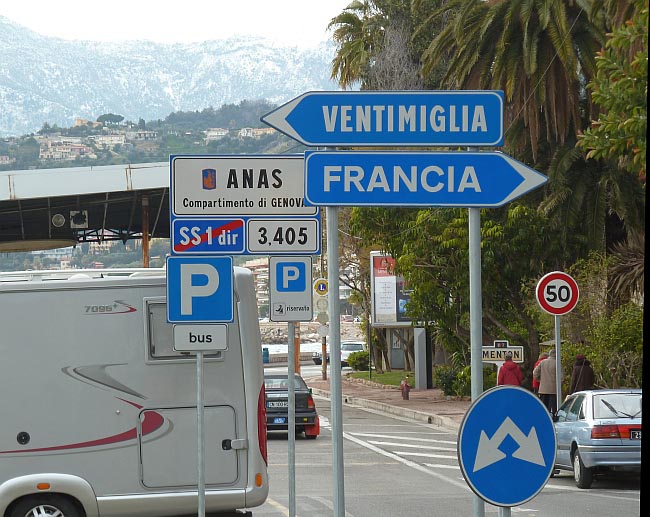 |
| Departing Italy west of Ventimiglia and arriving in Menton, France |
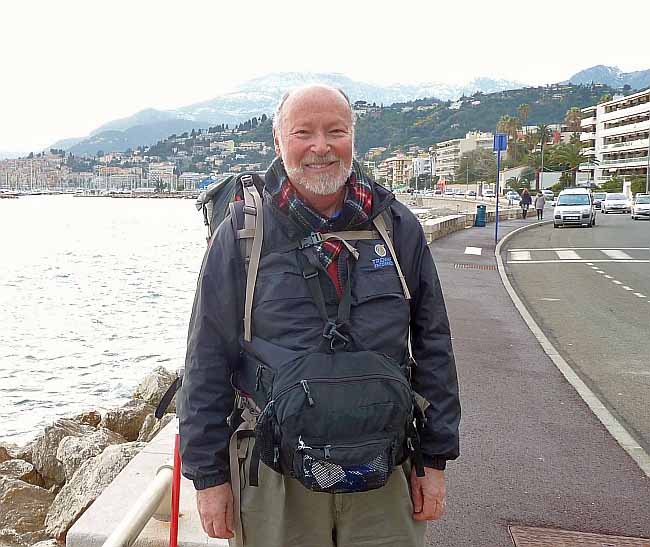 |
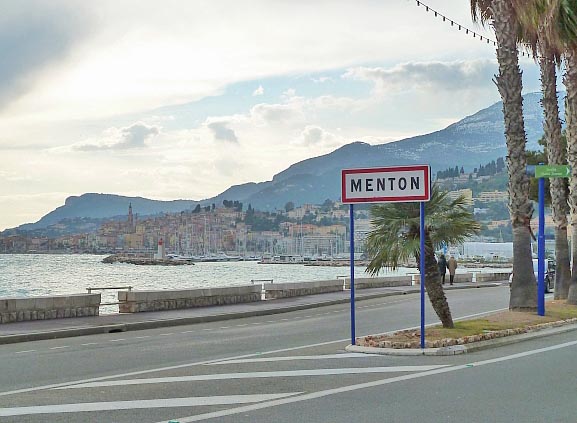 |
|
Let's go! This is the day I had waited and planned for. In the vernacular of my engineering days, I'd been "coiled" and was now unleashed. At a younger age, I might have skipped down the street inviting the French to on y va alongside me. My last long-distance hike was three years ago, and I was ready. It was unusual to start with my body in the right time zone. This time round, I had traveled from Venice and not the U.S. Still, yesterday, I rode the trains to Menton, France - missing a connection in Milan, and experiencing a horrible second one - a cross-border train that sat for an hour in Ventimiglia, Italy, sardine-canning some hundreds of standing passengers. So I hadn't escaped all travel-weariness. On arriving in France at Menton Garavan station, I backtracked a few hundred yards to the Italian frontier, and then re-entered France as a hiker arriving from Italy on foot - such being the protocol for a person determined to refuse any transportation but his own legs. The border has an old, now-unmanned customs house. Besides a flag or two and some traffic signs, the area is just a parking spot for RVs. There were no formalities. I reached my hotel on the west side of Menton easily enough, ate a couple of granola bars, slept, showered, breakfasted - and was on the road before 8 am. Today's hike to Monaco and beyond was mainly urban, on roads following the coastline. These roads are built in tiers on sometimes-steep hillsides rising from the sea. Along this coast, such a road is known as a corniche. There may be lower, middle and upper corniches. Typically, the upper one is a freeway which bypasses the towns, preserving them from through traffic. Every few miles, a cape or promontory juts into the sea, presenting a hilly obstacle to all coastal traffic. Having researched my route, I'd decided not to follow the winding roads that surmount the first of these capes (Cap Martin), but to take a set of stairs that heads more steeply over it. My first such stairway ran hundreds of feet, without level stretches to relieve the exertion. No wonder there was a taxi rank when it crossed over a street. Monaco is quite fascinating, not just for being a miniature country and tax-haven, and for its gambling and royalty. Its towering new buildings, pristine roads and sidewalks, and hugely affluent port and stores spoke of a modern, exclusive city. For every major arterial that carves its way through the city, there is another running in tunnels - as does the railroad - to preserve the city's pedestrian life. Constrained by a population density twice that of Hong Kong, they have done the best with the available space of just 0.8 sq miles. For trivia lovers, Monaco is the principality or state surrounding the city of Monte Carlo. Who
lives here? Whoever they are, they have money, and close-at-hand is a
responsive government willing to provide services. There are free public elevators
to waft the citizenry between the several levels of the hillside
streets.
They keep things spotless. The street cleaning
vehicles spray and brush not just the street but the sidewalk.
(Thinking it courteous of me to cross to the opposite sidewalk, I waved
to the driver in a friendly way, but he didn't acknowledge me in the
slightest - and would likely have sprayed and brushed me if
he
could.)
Who lives here - to repeat the question? There are consulates here which would surely be better located in bigger and less remote cities. Do the impoverished citizens of Gabon and Pakistan really need consulates in Monaco - or do they just provide jobs for their rulers' friends who can live in luxury at the expense of their countries' citizenry - while assisting their nation's politicians launder ill-gotten gains? Or is it that Monaco's sovereignty - a voting member of the U.N., no less - just makes foreign consulates obligatory? Contemplating these questions - for what else does a hiker do with his long day? - I walked past a Maserati dealer displaying a defibrillator station sign on his building facade. Was this because his customers may need cardiac attention, or an image-softening gesture, like a bank offering free cookies? If the world economy is suffering, Monaco seems nicely unaffected. Perhaps there's a seamier, industrial side to the place? I am sure there must be. But on my brief visit, the only sight that qualified was a light industrial area in which hugely expensive automobiles are repaired. Navigation was made
easier by advance planning, supplemented by excellent temporary
pedestrian walkways when construction intervened. The construction is
to add even more significant high-rises to the steep hillsides.
It
took a while to walk through Monaco, and there was more to ponder than
I have briefly mentioned. It's not exactly normal hiking territory, but
more
stimulating than striding past sheep. I'd planned a really easy first day to Monaco, but felt happy to continue beyond to stop at a place you can search for called avenue de la gare, in Mala, near Cap d'Ail, France. Taking credit for an earlier long descent towards a coastal footpath, which had to be reversed when construction snuffed out any hope of continuing, I had advanced 13 miles from my start in Italy. Pictures on this page describe
yesterday's border crossing from Italy to Menton, France. My Monaco-and-beyond
pictures start below and continue on the next page.
|
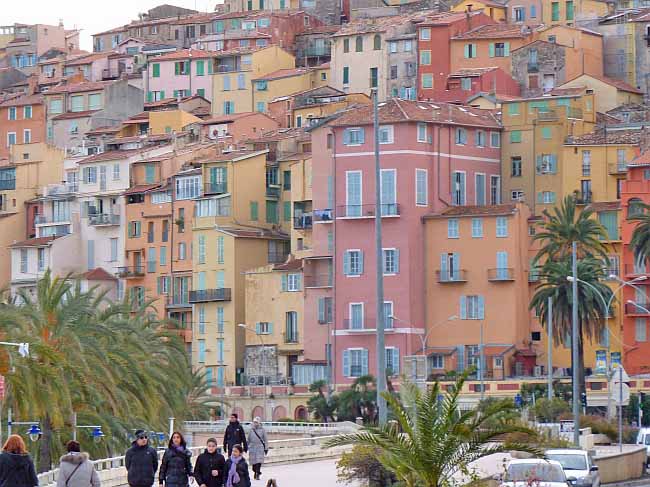 |
| Above, Menton
promenade; the sea is to the left, while homes run up the hill
and face the sea. Below, Monaco stretches from the second, small rocky promontary (left of mid-picture, "above" the pair of higher chimneys) to the most distant clump of buildings on the coast in the left distance. Cap d'Ail, the cape on the horizon, is in France. The French border parallels the coast scarcely a quarter-mile inland, which means that many of the buildings in the picture are in France. My overnight stay was somewhat beyond Cap d'Ail. |
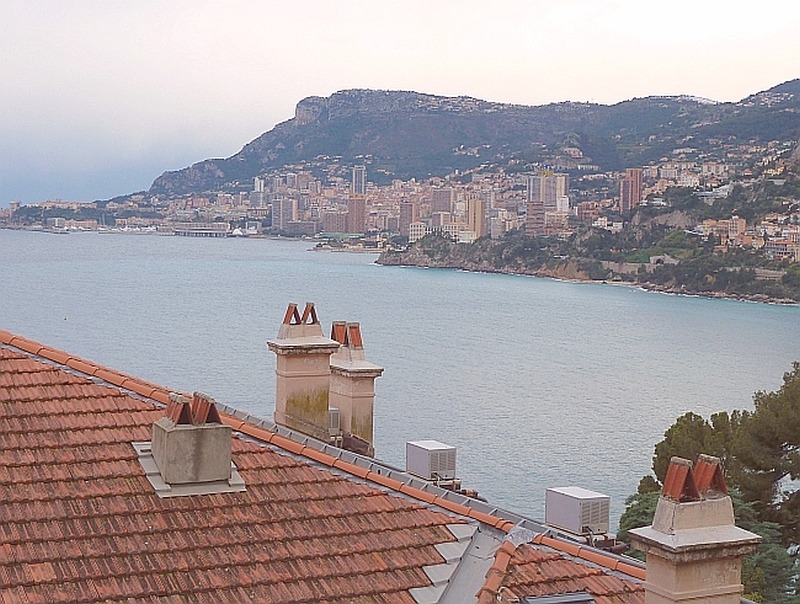 |
| Start Intro Part A - Index Day A2 |
© 2013 Daryl May |